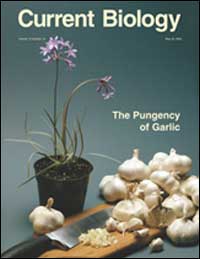Activation of thermoreceptors mediates raw garlic’s burning pungency

The worldwide popularity of garlic as a food ingredient and its therapeutic stature in folklore both stem in part from the distinctive pungency associated with its raw, uncooked state. Researchers this week report that this pungency, manifested as a characteristic mixture of burning and prickling sensations and flavor, can be ascribed largely to the effects of a particular compound and its ability to activate specific protein thermoreceptors in the mouth.
The findings are reported in the May 24 issue of Current Biology by a team led by Ardem Patapoutian of The Scripps Research Institute and the Genomics Institute of the Novartis Research Foundation.
Despite garlic’s popularity, the compounds responsible for its pungency, as well as the receptors through which we perceive those compounds, have remained unknown. In their new work, the researchers found that raw, but not baked, garlic was capable of eliciting responses from two so-called TRP (“trip”) channels, TRPV1 and TRPA1, which belong to a remarkable family of receptors that can be activated by temperature and chemicals. Some TRP channels, including TRPA1 and TRPV1, respond to both temperature and chemical compounds: TRPV1 is known to respond to noxious (painful) heat and to the pungent component of chili peppers, whereas TRPA1 is activated by noxious cold and by pungent compounds found in cinnamon oil, mustard oil, and wintergreen oil. These past findings, as well as the present work, indicate that thermosensitive TRP channels play a key role in the phenomenon of chemesthesis (the somatosensory contribution to the sense of taste), which is experienced, for example, in the heat of chili peppers or the coolness of peppermint. Both TRPV1 and TRPA1 are found in pain-sensing neurons that innervate the mouth and tongue.
The researchers went on to identify the sulfide compound allicin, an unstable chemical found in bruised, cut, or crushed garlic, as the chemical responsible for the activation of TRPV1 and TRPA1 and as the likely key chemical component responsible for garlic’s pungency. Allicin is converted to a variety of more stable sulfide compounds over time or with heating, in correspondence with the significantly milder taste of roasted garlic.
Garlic’s pungency most likely evolved as a defense mechanism against browsing by animals, and indeed many animals–though clearly not all humans–are known to be repelled by it.
Media Contact
All latest news from the category: Life Sciences and Chemistry
Articles and reports from the Life Sciences and chemistry area deal with applied and basic research into modern biology, chemistry and human medicine.
Valuable information can be found on a range of life sciences fields including bacteriology, biochemistry, bionics, bioinformatics, biophysics, biotechnology, genetics, geobotany, human biology, marine biology, microbiology, molecular biology, cellular biology, zoology, bioinorganic chemistry, microchemistry and environmental chemistry.
Newest articles

Superradiant atoms could push the boundaries of how precisely time can be measured
Superradiant atoms can help us measure time more precisely than ever. In a new study, researchers from the University of Copenhagen present a new method for measuring the time interval,…

Ion thermoelectric conversion devices for near room temperature
The electrode sheet of the thermoelectric device consists of ionic hydrogel, which is sandwiched between the electrodes to form, and the Prussian blue on the electrode undergoes a redox reaction…

Zap Energy achieves 37-million-degree temperatures in a compact device
New publication reports record electron temperatures for a small-scale, sheared-flow-stabilized Z-pinch fusion device. In the nine decades since humans first produced fusion reactions, only a few fusion technologies have demonstrated…





















